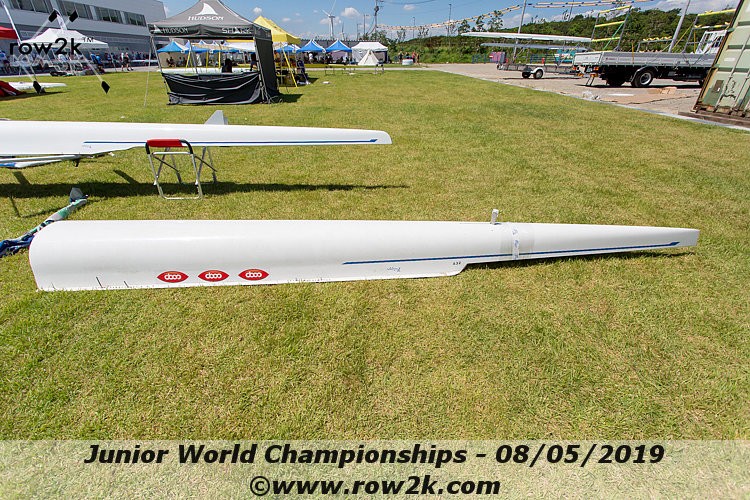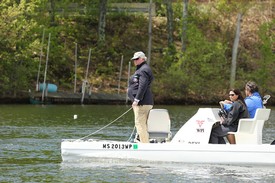
Recent events have not only put rowing on hold, but has also had the effect of freezing budgets as well. For many rowers and programs, this means getting another year or two out of your current fleet, so we spoke to three boatmakers to ask, now that purchasing is frozen or postponed in many places, what can teams and individuals do to prolong the life of their current equipment? Here is what they told us.
row2k: For relatively new boats, what parts or components are the first to need attention? Are there any very easy things to do to prevent wear? And for older boats, what parts or components replacement gives the most return on investment?
Alex Selvig of Elite Rowing/Filippi: On newer boats, do a routine wash with fresh water and dish soap, especially if you row in salt or brackish water. Keep the tracks and wheels clean. A wet rag is all you need. Do not use lubricant on the wheels, as it may deteriorate the plastic.
For older boats, new wheels and tracks first, and new oarlocks as needed. A smooth running seat will make the boat feel new.
Craig McAllister of HUDSON: The interaction of the wheel and slide is often overlooked with new boat Maintenance, but it's important to realize that premature wear on both parts is typically the result of third body wear; abrasives such as fine silt, sand, or salt that are introduced will wear and scratch the smooth protective coating on these parts, causing premature aging and replacement. Tip: Pay close attention to washing and cleaning wheels and slides after each row with soapy water and thoroughly rinse before racking hull-up for drainage.
John Tytus of Pocock: The most important thing to maintain on a shell is the hulls surface. Swapping worn shoes, wheels and tracks are pretty simple, really. Maintaining the hull though is a bit more labor intensive, and since the finishes that builders use now are so tough, most think that its maintenance-free. This is simply not the case. Cleaning and waxing is very important. Boat safe soaps with no harsh chemicals and any marine wax are what is suggested.

row2k: What about waxing boats in storage?
Tytus: Boat safe soaps with no harsh chemicals and any marine wax are what is suggested. The power of UV light and sun on these boats over many years can wreak havoc. Waxing is the best way to prolong the fine finish of a racing shell. You may want to strip the wax prior to the championship season.
row2k: What is the most cost-effective refit for older boats - replacing all the tracks, putting in all new shoes, repainting, other, none of these?
Selvig: A good cleaning with SoftScrub with bleach will make the hull look new. Check your nuts and bolts for corrosion or seizing, and replace as needed. Wheels and tracks, as noted above. Bent backstays can sometimes be straightened with a rubber mallet, and should be replaced if they can't be adjusted.
Tytus: For parts and gear maintenance, most noticeable to the athletes is obviously the shoes, and then wheels/tracks. Last would be worn oarlocks. Compared to the price of new boats, this maintenance is inexpensive, and ultimately results in a functionally new shell.
row2k: Are there any risks of having boats racked for several months?
Selvig: The biggest risk is animals or insects moving in. Other than that, none.
McAllister: Racking boats for an off-season or storage should be preceded by a 'winterization' preventative maintenance routine. After deep cleaning, rinsing, and drying the hull, cockpit, rigger(s), and components, fully open all vent caps and sealed chambers for drying. Rigger frames should be removed and stored separately with rigger hardware disassembled and stored in a dry place. If practical storing removable parts such as foot assemblies and seats in a warm and dry place is a good practice. As a minimum, loosen adjustable hardware, namely pin bolts and footstretcher adjustment bolts, before long term storage.

row2k: What additional things should you do for boats that had been rowed in salt water?
Selvig: Salt is the most dangerous thing for your boat. Periodic (every three months?), complete disassembly of every fastener should be undertaken. These parts should then be thoroughly washed in soap and fresh water and rinsed. Where dissimilar metals touch, or metal touches carbon fiber, we suggest using TefGel, a PTFE (Teflon) paste that creates an insulating barrier that prevents electron exchange or galvanic corrosion. Mariners swear by TefGel, and it is very effective.
row2k: What repairs or upkeep can be done by non-experts? What repairs should non-experts definitely not attempt?
Selvig: Simple hardware replacement and small paint touch ups are easy to do. Anything involving a hull puncture, crack, or larger repair should be handled by a pro.

row2k: What are lead times for parts delivery? Are there delays or supply shortages at all?
Selvig: Zero. Filippi is fully operational, and we've maintained a full inventory.
McAllister: Stock Parts Orders are processed daily M-F and shipped UPS Standard unless otherwise specified by the customer. Shipping delays have been experienced during the pandemic and could exceed one week for delivery. Note: custom orders such as riggers or some carbon parts have a longer lead time to factor on-demand production.
Tytus: For parts orders, being headquartered on the on the West coast, if you break a fin at pm practice on the east coast, we are still open for business and able to ship next day air. Most parts are always in stock and ready to ship. Sometimes parts that require some assembly can take a day or two, but usually everything can be received the next day.

If you enjoy and rely on row2k, we need your help to be able to keep doing all this. Though row2k sometimes looks like a big, outside-funded operation, it mainly runs on enthusiasm and grit. Help us keep it coming, thank you! Learn more.
Comments | Log in to comment |
There are no Comments yet
| |
- Bont Rowing
- Calm Waters Rowing
- Concept 2
- Craftsbury Sculling
- The Crew Classic
- CrewLAB
- Croker
- Dad Vail Regatta
- Durham Boat Co.
- Empacher
- Faster Masters
- Filippi
- Fluidesign
- h2row.net
- HUDSON
- Live2Row Studios
- Nielsen-Kellerman
- Oak Ridge RA
- Peinert Boat Works
- Pocock Racing Shells
- Race1 USA
- Rockland Rowing Masters Regatta
- RowKraft
- Rubini Jewelers
- Vespoli USA
- WinTech Racing
- Bont Rowing
- Calm Waters Rowing
- Concept 2
- Craftsbury Sculling
- The Crew Classic
- CrewLAB
- Croker
- Dad Vail Regatta
- Durham Boat Co.
- Empacher
- Faster Masters
- Filippi
- Fluidesign
- h2row.net
- HUDSON
- Live2Row Studios
- Nielsen-Kellerman
- Oak Ridge RA
- Peinert Boat Works
- Pocock Racing Shells
- Race1 USA
- Rockland Rowing Masters Regatta
- RowKraft
- Rubini Jewelers
- Vespoli USA
- WinTech Racing

















